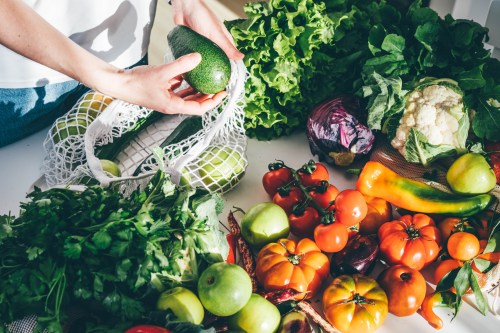Our editors independently select these products. Making a purchase through our links may earn Well+Good a commission
I’m a Registered Dietitian, and Here’s What I Think of the Ever-Viral Bloom Greens Drink Powder
See whether this registered dietitian gives the buzzy Bloom Nutrition Greens & Superfoods powder her stamp of approval.

When it comes to viral health trends, few brands compare to the popularity of Bloom Nutrition Greens & Superfoods powder. In fact, if you’re a Tiktoker, odds are very high that this up-and-coming brand has popped up on your For You page. From sorority sisters to influencers, this woman-founded company for women has resonated with so many girlies across the nation. And it’s no wonder, with the wide variety of products and appetizing flavors they offer across the brand. Plus, the touted health benefits are hard to ignore, ranging from sustained energy to better digestion and immune health.
But are Bloom’s products as incredible as social media may lead us to believe? As a registered dietitian, I took a deep dive into the brand, looking closely at its products’ ingredients and health claims.
What is Bloom Nutrition?
With over 600,000 followers on Tiktok, a best-selling product on Amazon, and contracts with Target and Walmart, it’s safe to say that Bloom Nutrition has gained some serious traction within the health and wellness space. This company was started by Mari Llewellyn and her husband Greg LaVecchia in 2019. Llewellyn was looking for a supplement brand that offered energy and health-boosting products that both tasted amazing and featured better-for-you ingredients…so she built one.
And while it’s the Bloom Nutrition Greens & Superfoods powder that put them on the map, the brand now offers a much more diverse selection of health-focused products. These include protein powders, pre- and post-workout powders, matcha, collagen creamer, collagen peptides, vitamins, fish oil, and even sleep aids. Though most of these products come in tubs, a few are sold in easy-to-use sachets for accessible nutrition on-the-go. The flavors of these products are notably unique, to say the least, with options like blueberry muffin, cinnamon bun, raspberry lemonade, and even cookies and cream. This fact alone illustrates how the brand appeals to younger audiences.
The health claims on these products are nearly as sizable as their product collection, ranging from improved gut, brain, heart, hair, skin, and nail health, to better immunity, sleep patterns, and energy levels.
So, as a registered dietitian for nearly a decade, what are some of my biggest takeaways on this viral brand?
After a thorough examination of all the products available on Bloom’s website, my overall impression was fairly positive. Many of the products are full of recognizable and generally beneficial ingredients like vitamins, minerals, digestive enzymes, probiotics, fruits, and veggies. The majority are also soy, dairy, and gluten-free, increasing their accessibility to a wider audience.
However, there were some obvious additives in many of the products like artificial flavoring, xanthan gum, and silicon dioxide. And while these ingredients are recognized as safe, they generally haven’t been around long enough for us to get a full understanding of their long-term impacts.
However, the most common ingredients in the Bloom products that raised red flags for me were sucralose (aka Splenda), acesulfame potassium, and stevia—three common artificial sweeteners. Though these are also generally recognized as safe by the Food and Drug Administration (FDA), there is some concerning research surrounding them. A 2022 study of over 100,000 people found a potentially direct correlation between Splenda and acesulfame potassium and heart disease.
Meanwhile, though a naturally derived product, evidence also shows that long-term use of stevia even in small amounts may disrupt the homeostasis of the gut microbiome. Also, many people generally report gastrointestinal (GI) symptoms like gas, bloating, and diarrhea with these alternative sweeteners, which is generally the opposite effect Bloom is going for.
Is Bloom Nutrition Greens & Superfoods Powder powder all it’s chalked up to be?
Overall, the Greens & Superfoods powder has a lot of buzzworthy ingredients that we know are loaded with vitamins, minerals, and plant compounds. Some of these include spirulina, wheatgrass, flax, carrot, kale, spinach, tart cherry, goji, and acai. Plus, it contains some of the most mainstream herbs that offer both micronutrients and adaptogenic benefits like ashwagandha, rhodiola, ginseng, and licorice, on top of gut-boosting digestive enzymes and probiotics. Many, but not all, of these ingredients are organic and the product is free of soy, gluten, and dairy. This powder is also manufactured in a cGMP (Certified Good Manufacturing Practices) facility, meaning that it follows FDA-set operation standards, though most companies do.
This powder is supposed to boost energy levels, support gut and digestive health, and debloat. However, none of these claims are substantiated by research conducted on the product itself nor is it third-party tested for ingredient verification or purity standards. These elements are something I always look for with supplement brands as they are not closely regulated by the FDA, leaving the responsibility for safety and labeling accuracy in the hands of the brand.
Also, though most of the ingredients found in this popular supplement are known health foods, when dried and powdered they are stripped of their fiber and water content—key nutrients for gut health. It’s also likely that many of the bioactive plant compounds and micronutrients found in these foods have degraded during processing. This means that we’re missing out on the full health benefits that these healthy ingredients offer us. Whereas, if we ate these foods in their whole form, we would be reaping their full nutritional benefits.
Also, because of the lack of testing and claims verification, we don’t actually know if these ingredients are included in amounts high enough to actually provide true therapeutic benefit. Plus, while Splenda and acesulfame potassium are notably left out of this product, it does contain stevia, which I usually tend to avoid.
So, while buzzworthy, at nearly 40 dollars for 30 servings, Bloom Nutrition Greens & Superfoods powder may be a little pricey for the unsubstantiated benefits. That being said, I don’t think consuming this powder in moderation is harmful to your health by any stretch. At its best, it serves as a nice health booster, and at its worst, it doesn’t do much for our bodies. I have heard reports that it actually caused bloating in some people, however, but I haven’t experienced that myself.
I’d say the same for the other products Bloom offers, although I personally would steer clear of offerings with sugar substitutes or excessive amounts of mystery additives. I actually think their ceremonial grade Mari’s Matcha looks great.
Ultimately, as with all dietary supplements, these seemingly quick fixes shouldn’t replace whole foods and balance in our diet. Rather, they should serve as little health boosts that we can turn to on days when we may not have gotten enough nutrient-rich foods, and Bloom’s trendy products are no different.
Sign Up for Our Daily Newsletter
Get all the latest in wellness, trends, food, fitness, beauty, and more delivered right to your inbox.
Got it, you've been added to our email list.










